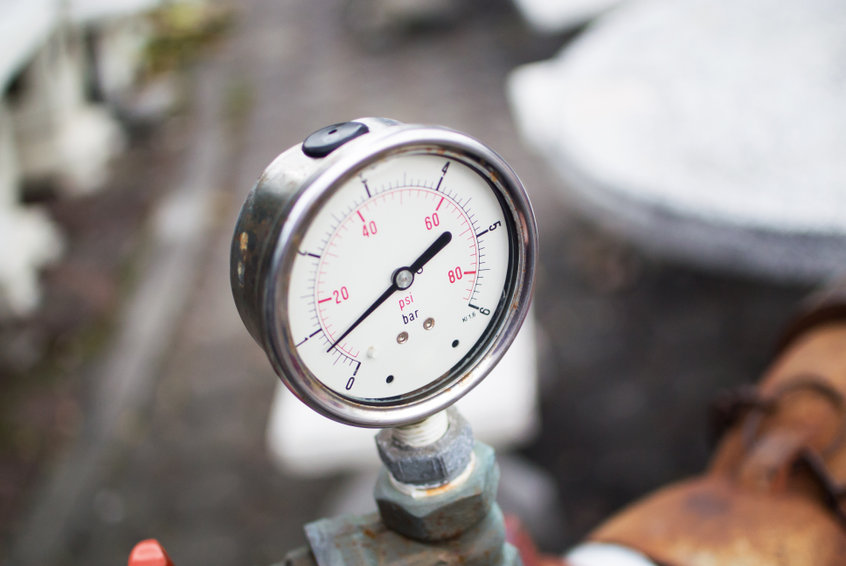Preventing Pressure Spikes in Pressure Transducers
Most often used to measure pressure in fluid power applications, pressure transducers are usually specified with an allowance for over-pressurization and can operate trouble-free in a fluid power system that experiences mild pressure spikes from time to time. However, in some instances, pressure events will exceed normal operating pressure limits, causing a permanent shift in the transducer’s signal output and/or complete failure of the transducer. Pressure spikes, also known as pressure overloads and pressure events, can occur for several reasons. This article will examine possible causes and discuss ways to prevent pressure spikes in fluid power applications.

What is a Pressure Transducer?
Pressure transducers are sensors that convert physical pressure into an electrical signal that is used for measuring the pressure of a fluid within a fluid power system. Most pressure transducers rely on gauges that are bonded to an internal diaphragm, which serves as the “force collector” of the transducer. In other words, as pressure is applied to the transducer, the diaphragm deflects and causes the gauge to compress, thus altering the output signal. The resulting measurement is used to control and monitor pressure in the system or process. The technology can also be used to measure flow and level in fluid power or pumping systems. Pressure transducers are available in a range of materials and technologies, permitting use in many conditions and applications from benign to corrosive to high pressure and high temperature environments.
What Causes Pressure Spikes?
A pressure spike is a sudden pressure overload that occurs over a short duration and can sometimes exceed the transducer’s normal operating pressure limits. Very high pressure spikes can lead to premature failure in transducers, throwing off the accuracy of measurements and negatively impacting the process or system operation.
Causes of pressure events vary, but there are several possibilities, including:
- Fast-acting valves: If a transducer is in close proximity to an opening and closing valve, the rapid movement of the valve may create surges downstream from the valve. These pressure surges may be strong enough to deform the transducer’s diaphragm or damage its sensing element.
- Sudden changes in flow: Similarly, severe pressure spikes can be caused by rapid changes in the flow, direction or momentum of fluids, which can be caused by system components such as pumps, valves, pistons and rams.
- Air entrapment: If air becomes trapped within the fluid of the system, pressure events may result. Known as “water hammer,” this phenomenon is a pressure wave that occurs when a fluid in motion is forced to suddenly stop or change direction. Air may become trapped within the fluid due to fast-acting valves or other system components that abruptly open, close or change direction, trapping air inside the fluid, which becomes pressurized. A tell-tale sign of a water hammer is knocking within the pipes. In addition to creating pressure spikes that can alter the performance of or cause failure in pressure transducers, water hammers can have other dangerous and costly consequences, including the destruction of pipes.
- Icing: Like air, water can become trapped within a fluid system and, if exposed to freezing temperatures, it can freeze, which will simulate a pressure spike as the transducer cannot differentiate between pressure and ice. Long-term exposure to icing conditions can result in pressure spikes and premature failure of the transducer.
- Improper selection or installation: As precision measurement devices, pressure transducers must be carefully selected for the application, meaning they should be rugged enough and contain the appropriate technology for the application. In addition, they should be properly specified according to the standard operating pressure of the system. Pressure transducers must be installed correctly to ensure optimal performance. All wiring and mechanical connections must be set up properly to prevent problems.

How to Avoid Pressure Spikes
While it can be difficult to predict pressure spikes, if a system is known to experience such events it is important to take preventive measures to avoid inaccurate readings and premature failure of the transducer. Experts recommend the following:
- Proper selection and installation of the transducer: Transducers with a greater pressure range should be used to replace transducers that have failed due to a prior pressure spike. As an alternative to simply increasing the pressure range, consider technologies with thicker diaphragms and a higher proof pressure. Some manufacturers can calibrate the transducer for the proper pressure range, but incorporate a higher proof pressure. This will provide accurate measurements and performance, but accommodate higher proof pressures and is ideal for pressure spikes caused by icing conditions. In either case, be sure the transducer is properly installed.
- Bleed air from the system: To avoid water hammer and air entrapment, be sure to bleed air from the fluid system prior to start up.
- Reduce piping lengths: The shortest allowable length of piping should be used to connect the transducer to the measurement point of the transducer to avoid over pressurization caused by sudden changes in flow.
- Reduce valve speed: By slowing the opening and closing rate of fast-moving valves, it is possible to reduce and/or eliminate the pressure surges caused by the swift opening and closing of valves.
- Employ a snubber: In cases where the pressure spikes are many times greater than the normal operating conditions, the use of a snubber, a device that can be placed at or near the transducer, will limit the effects of spikes that result from sudden changes in fluid momentum. Snubbers successfully absorb the pulses and shocks caused by fast moving valves and other components that quickly alter the direction or momentum of the fluid. Snubbers must be properly sized and can be incorporated into new transducers by the manufacturer or added as an adapter accessory.
For assistance selecting a pressure transducer, please contact a JHFOSTER representative.
